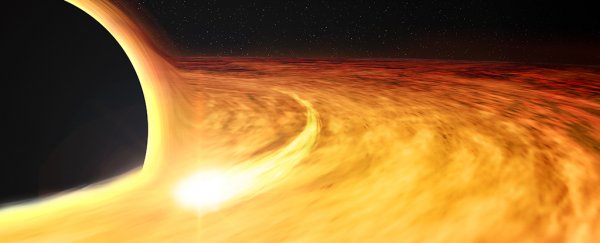Black holes are mysterious cosmic destroyers, but we just got one step closer to figuring out one of the key characteristics of how they work: how fast they're spinning.
Peering into the event horizon of a black hole, astronomers have detected brief X-ray pulses that indicate a rotation speed of a gob-smacking 50 percent of the speed of light.
The X-ray pulses were emitted by a dying star as it was sucked into the black hole – like its final screams being heard across the Universe.
While we've come a long way in our understanding of black holes in recent years – including figuring out their mind-crushing scale – their spin or oscillation rate is a lot harder to calculate than their size, because we've got fewer clues to go on.
But now astronomers think the streams of electromagnetic energy emitted by stars as they get sucked into nothingness might help.
The new readings were taken from a supermassive black hole some 290 million light years
Measurements taken through multiple telescopes show brief blips of X-ray energy being released, apparently just as debris from a disintegrating star circles the black hole's event horizon – the point just before complete oblivion.
This new technique could also be particularly useful for spotting inactive black holes classed as dormant, which are hard to spot in space.
"Events where black holes shred stars that come too close to them could help us map out the spins of several supermassive black holes that are dormant and otherwise hidden at the centres of galaxies," says one of the researchers, Dheeraj Pasham from the Kavli Institute for Astrophysics and Space Research at MIT.
"This could ultimately help us understand how galaxies evolved over cosmic time."
What we're technically talking about here is a tidal disruption flare, the name for the moment when a star wanders too close to a black hole and starts to get ripped apart.
The researchers think the bits of leftover star providing energy pulses circle around the innermost stable circular orbit (ISCO) of the black hole – the last point of safety before destruction. The X-ray signals should indicate the size of the ISCO, the team says, and the size of the ISCO should tell us the black hole spin rate.
In this case, scientists measured bursts of electromagnetic energy every 131 seconds over the course of 450 days. That data, along with the black hole's mass, suggests the supermassive black hole at the centre of the event labelled ASASSN-14li is spinning at 50 percent the speed of light.
It's the first time a tidal disruption flare has been used to judge the spin of a black hole. Figuring out a black hole's mass is a little easier, by the way, because the pull it has on the galaxy around it can be measured to calculate an estimate.
So how do you go about getting a look at this process in action? The destruction event itself was first spotted in November 2014, and data from the ESA XMM-Newton, NASA Chandra and NASA Swift telescopes was used to take a closer look, with special algorithms deployed to bring up patterns in the readings coming back.
What makes the discovery so exciting is that the observed data matches many earlier theoretical models of tidal disruption flares and their relationship to black holes. Experts estimate that some black holes spin at up to 99 percent the speed of light, but this latest study offers a way of being able to know for sure.
The only problem might be the rarity of this sort of scenario: the researchers think a small white dwarf star was keeping its distance from the black hole undetected, until a second star arrived that was pulled into the black hole's clutches.
As the second star disappeared, the remnants that astronomers have now identified would have been dragged into the white dwarf's wake, allowing us to see it for the first time – essentially lighting it up so it could be detected by telescopes.
"We would've been extremely lucky to find such a system," says Pasham. "But at least in terms of the properties of the system, this scenario seems to work."
"In the next decade, we hope to detect more of these events. Estimating spins of several black holes from the beginning of time to now would be valuable in terms of estimating whether there is a relationship between the spin and the age of black holes."
The research has been published in Science.
